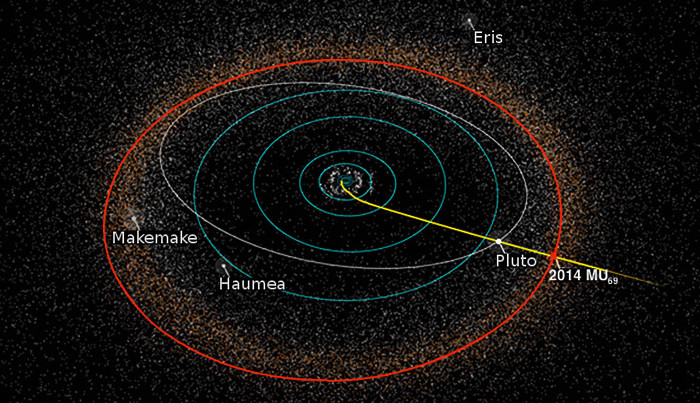Great news from the Kuiper Belt
January 02, 2019
on
on

The NASA spacecraft New Horizons sent a signal on the 1st of January 2019 to indicate that it had completed a successful fly-by of Ultima Thule; a lump of material which as far as we know has been orbiting the sun in the Kuiper Belt ever since the solar system was formed. Some of the initial low-res pictures sent earlier shows Ultima Thule is shaped like a giant bowling pin (or is it two distinct co-orbiting masses?). The message received from New Horizon was effectively ‘Ultima Thule flyby successful’ and engineers were able to ascertain relatively quickly that the appropriate number of files containing sensor data and images had been stored to the on-board hard disks. Now comes the tantalising part where all that data is slowly transferred back to earth.
During its earlier remarkable fly-by of Pluto and its moons New Horizons captured 6.25 GB of data which took 469 days to send back to Earth via its downlink which at that time was capable of a transfer rate of around 38 Kbits/s. Considering its current location, 4 billion miles from Earth, engineers expect the downlink will achieve around 2Kbits/s. The Long Range Reconnaissance Imager (LORRI) captures the images. It has an 8.2-inch reflecting telescope focussing light onto a CCD detector in the Focal Plane Unit to produce pictures with a resolution of 1024 by 1024 pixels. The instrument is sensitive to visible radiation in the range from 350 to 850 nm.
LORRI supports exposure times from 1 millisecond to 29.9 seconds. At the far reaches of the solar system light levels are very low and exposures are typically 50 to 200 milliseconds optimized for spacecraft pointing. The panchromatic (black and white) images are recorded onboard as a set of 12-bit integer values representing light levels from 0 to 4095. On reception these values are converted to 32-bit double-precision numbers and then to lower resolution 8-bit JPEG files for use on web pages. The Focal Plane Assembly also includes a switchable 4×4 on-chip binning option to deliver low resolution 256 by 256-pixel images.
Excitement mounts as we standby for the first hi-res image to appear…
During its earlier remarkable fly-by of Pluto and its moons New Horizons captured 6.25 GB of data which took 469 days to send back to Earth via its downlink which at that time was capable of a transfer rate of around 38 Kbits/s. Considering its current location, 4 billion miles from Earth, engineers expect the downlink will achieve around 2Kbits/s. The Long Range Reconnaissance Imager (LORRI) captures the images. It has an 8.2-inch reflecting telescope focussing light onto a CCD detector in the Focal Plane Unit to produce pictures with a resolution of 1024 by 1024 pixels. The instrument is sensitive to visible radiation in the range from 350 to 850 nm.
LORRI supports exposure times from 1 millisecond to 29.9 seconds. At the far reaches of the solar system light levels are very low and exposures are typically 50 to 200 milliseconds optimized for spacecraft pointing. The panchromatic (black and white) images are recorded onboard as a set of 12-bit integer values representing light levels from 0 to 4095. On reception these values are converted to 32-bit double-precision numbers and then to lower resolution 8-bit JPEG files for use on web pages. The Focal Plane Assembly also includes a switchable 4×4 on-chip binning option to deliver low resolution 256 by 256-pixel images.
Excitement mounts as we standby for the first hi-res image to appear…
Read full article
Hide full article


Discussion (0 comments)